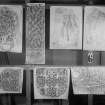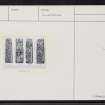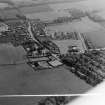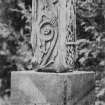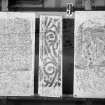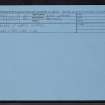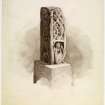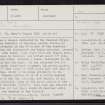Pricing Change
New pricing for orders of material from this site will come into place shortly. Charges for supply of digital images, digitisation on demand, prints and licensing will be altered.
Aberlady, St Mary's Chapel
Burial Ground (Medieval), Chapel (Medieval), Coffin(S) (Medieval), Cross Slab (Anglian)
Site Name Aberlady, St Mary's Chapel
Classification Burial Ground (Medieval), Chapel (Medieval), Coffin(S) (Medieval), Cross Slab (Anglian)
Alternative Name(s) Aberlady Parish Burial-ground
Canmore ID 54866
Site Number NT47NE 1
NGR NT 4614 7988
Datum OSGB36 - NGR
Permalink http://canmore.org.uk/site/54866
- Council East Lothian
- Parish Aberlady
- Former Region Lothian
- Former District East Lothian
- Former County East Lothian
Aberlady (St Mary), East Lothian, cross-shaft
Measurements: H 0.61m, W 0.17m to 0.26m, D 0.17m to 0.18m
Stone type: sandstone
Place of discovery: NT 4614 7988
Present location: National Museums Scotland, Edinburgh (IB 298)
Evidence for discovery: found in 1863 built into the garden wall of the manse at Aberlady, close to the site of St Mary’s Chapel. It stood in the manse garden until sometime between 1889 and around 1900, when it was taken to Carlowrie Castle, where it stood on a plinth first in the grounds and later in the castle vestibule. In 1966 it was donated to the museum.
Present condition: broken and worn.
Description
This is a central portion of a very fine Anglo-Saxon cross-shaft, ornamented in relief on all four faces. Each edge has a plain roll moulding with a smaller roll moulding framing the panels of ornament. There are parts of two panels on face A, the lower containing a winged angel and the upper two intertwined animals with elongated bodies. Of the two panels on face B, the lower contains diagonal key pattern and the upper four entwined birds with long necks. Faces B and D are carved with foliate scrolls with ridged nodes and triangular berry bunches. Though similar, they are not identical in the arrangement of their leaves: on face B there are alternate sprays of two and three leaves, while on face D there are only two-leaf sprays. Traces of tin lining were found in the deeply drilled eye sockets of the birds on face B, indicating that they once held decorative insets (Blackwell 2012, 66, fn 183).
Date: late eighth or early ninth century.
Desk-based information compiled by A Ritchie 2016
NT47NE 1 4614 7988
See also NT47NE 17.
(NT 4614 7988) St Mary's Chapel (NR) (site of)
OS 6" map (1968)
There was a chapel dedicated to the Blessed Virgin Mary within the cemetery of Aberlady parish church. It was situated in the NW corner of the cemetery; about 1927, when the churchyard was being extended, several stone coffins were found, some 30yds from the chapel site. The only one seen by Caldwell was buried about 10' down, and was of solid stone, without a cover, chiselled to the shape of a body and the head. It was oriented E-W (information from T Caldwell, Aberlady, to A S Henshall, NMAS, 14 December 1956).
A sandstone cross-slab fragment, measuring approximately 2' by 7 1/2" by 7", was found in 1863 built into the wall of the manse garden, which is in close proximity to the chapel site. Clapham states it is of a purely Anglian type, dateable to the 7th century and should, in all historical probability, date to the short period of the Anglian see of Abercorn (681-5). This slab was removed to Carlowrie Castle (NT 142 744 NT17SW 52.01), where it remained until 1966, when it was donated to the National Museum of Antiquities of Scotland [NMAS].
RCAHMS 1924, visited 1914; 1929, visited 1926; J R Allen and J Anderson 1903; A W Clapham 1930; Proc Soc Antiq Scot 1968
Field Visit (25 October 1962)
There are no surface remains of St Mary's Chapel, but the foundations are encountered from time to time during grave digging in the enclosure, at NT 4614 7988, in the NW corner of the old churchyard.
Visited by OS (RDL) 25 October 1962
Field Visit (9 July 1975)
The cross-slab, as described, is now on display in Aberlady Parish Church.
Visited by OS (SFS) 9 July 1975
Reference (1978)
The cross fragment noted by OS (SFS) is a replica. The original dates from the 8th century.
C McWilliam 1978


















